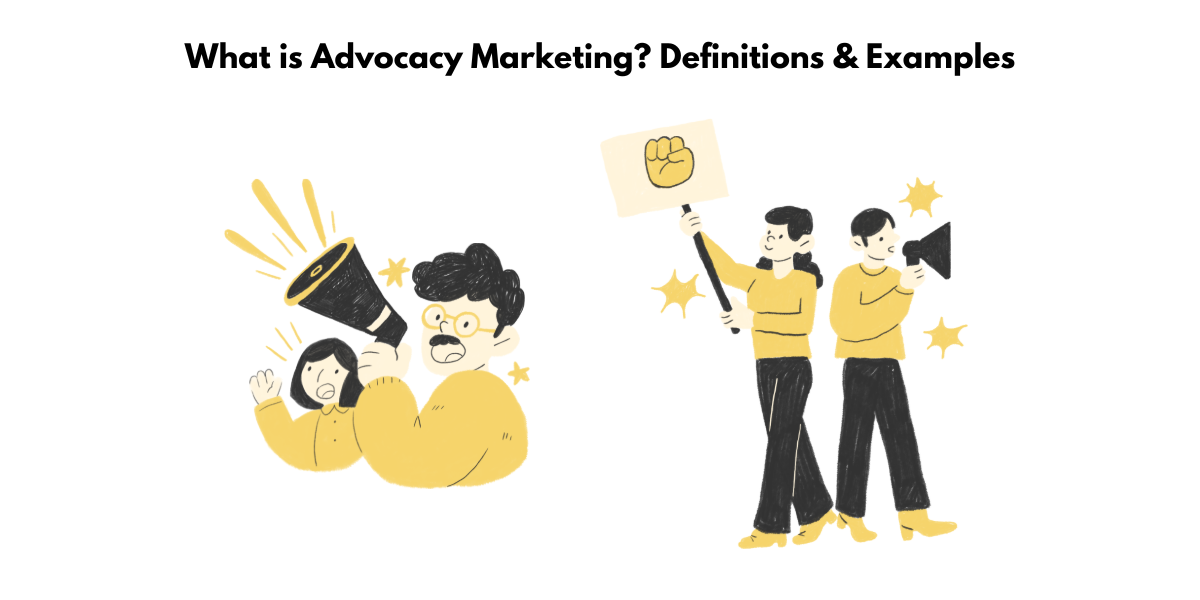What is Advocacy Marketing?
Defining the Concept
Advocacy marketing is a strategy where brands leverage their satisfied customers to promote their products or services. These customers, known as brand advocates, share positive experiences with their networks, effectively boosting organic marketing efforts through genuine endorsements. The focus is on building a community that passionately supports the brand, going beyond traditional marketing tactics to create lasting relationships. In essence, advocacy marketing taps into the power of word-of-mouth, amplified by social media platforms, to drive brand growth and loyalty.
Key Differences from Influencer Marketing
While both advocacy and influencer marketing rely on individuals to promote a brand, they differ significantly in approach and execution. Advocacy marketing leans on everyday customers who genuinely support and endorse the brand, often without monetary compensation. These advocates share their positive experiences voluntarily, motivated by true satisfaction and loyalty. In contrast, influencer marketing involves individuals with large followings who are paid or given incentives to promote products or services. Influencers often act as paid ambassadors of a brand, which might not always reflect genuine personal use or endorsement. This makes advocacy marketing more authentic and trustworthy, as advocates are real customers sharing real experiences.

Why Advocacy Marketing Matters
Benefits for Brand Growth
Advocacy marketing offers numerous benefits that contribute to brand growth. Firstly, it significantly boosts organic reach. When advocates share their positive experiences, it can result in a viral word-of-mouth effect, extending your outreach exponentially, often for minimal cost. Secondly, it enhances customer retention by fostering a sense of community and loyalty among brand advocates. Thirdly, it drives higher conversion rates. Potential customers are more likely to trust recommendations from real users rather than traditional advertisements. Fourthly, advocacy marketing strengthens your brand image by associating it with real-world testimonials. Lastly, it provides valuable insights and feedback, aiding in the improvement of products and services, which further solidifies growth.
Building Trust and Credibility
Advocacy marketing is a powerful tool for building trust and credibility because it leverages genuine customer experiences. Consumers today are more skeptical than ever of traditional advertising, preferring to hear honest opinions from those they perceive as authentic and relatable. Advocates serve as trustworthy voices, offering real-life testimonials that resonate more personally with potential customers. This kind of user validation can drastically reduce skepticism and increase brand credibility. Trust is also built through transparency and engagement, as advocates often openly discuss both the pros and cons of their experiences, making the endorsement feel more sincere. By nurturing these authentic interactions, brands can cultivate a loyal customer base that not only trusts but also champions their offerings.

Effective Advocacy Marketing Strategies
Utilizing User-Generated Content
User-generated content (UGC) is a cornerstone of effective advocacy marketing strategies. By encouraging satisfied customers to create and share content related to your brand, you tap into genuine voices that resonate with a broader audience. UGC can take many forms, including reviews, testimonials, social media posts, or even creative content like photos and videos that feature your products. This type of content not only amplifies your brand’s reach but also adds an authentic dimension that is hard to replicate with traditional marketing efforts.
To utilize UGC effectively, brands should actively engage with their audience, prompting them to share their experiences and rewarding them when they do. Creating branded hashtags, hosting contests, or featuring top user content on your official channels are great ways to encourage participation. This approach not only generates organic content at a fraction of the cost but also fosters a community feeling among your customer base, which further enhances loyalty and advocacy.
Implementing a Customer Referral Program
Implementing a customer referral program is a strategic way to enhance advocacy marketing efforts by turning customers into proactive promoters. A well-designed referral program incentivizes current customers to introduce new potential customers to your brand in exchange for rewards. These incentives can be discounts, freebies, or loyalty points, making it appealing for advocates to share their positive experiences.
To establish a successful referral program, start by setting clear and achievable goals. Ensure the process is simple and straightforward—customers should understand exactly what they need to do to participate. Providing personalized referral links or codes can simplify tracking and make it easier for customers to share your brand with their network. Additionally, celebratory recognition of successful referrers can boost engagement and motivation. Another key element is transparency about rewards and how they can be earned, which sustains interest and trust in the program.
This strategy not only extends your reach organically but also attracts potential customers through trusted sources, leading to higher conversion rates and brand loyalty.
Incentivizing Advocates
Incentivizing advocates plays a crucial role in sustaining an active and engaged community around your brand. When customers are rewarded for sharing their positive experiences, it encourages continued advocacy and attracts new potential advocates. Incentives need not always be monetary; they can be exclusive access to new products, special discounts, recognition on social media, or even membership in a brand ambassador program.
The key is to tailor these incentives to align with what your advocates value most. Understanding your customer’s preferences and motivations can help in designing rewards that feel both personal and valuable. Regularly updating and rotating incentives can also keep advocacy efforts dynamic and exciting. Offering tiered rewards based on different levels of engagement or advocacy can further motivate advocates to increase their involvement with the brand.
Incentivization not only sustains advocacy momentum but also strengthens emotional bonds between the advocates and your brand, driving sustained loyalty and enhanced marketing reach.

Real-World Examples of Successful Advocacy Marketing
Tesla’s Innovative Approach
Tesla’s approach to advocacy marketing is a masterclass in leveraging customer satisfaction to drive brand growth. The company employs a strategic referral program that rewards customers with benefits like charging credits and invites to exclusive events. This not only incentivizes current users to recommend Tesla but also makes them feel part of an exclusive community.
Moreover, Tesla taps into the uniqueness of its brand and products. Owners often become advocates simply due to their passion for innovation and sustainable technology—a sentiment that Tesla actively nurtures through user engagement and by maintaining a robust presence on social media platforms. This genuine enthusiasm fuels word-of-mouth marketing that is both authentic and effective.
Tesla’s advocacy model goes beyond standard promotions, focusing on building an ecosystem of dedicated customers who extoll the virtues of their products willingly. This strategy amplifies the brand message in a way that resonates with potential buyers.
Apple’s Seamless Integration
Apple’s advocacy marketing strategy hinges on creating exceptional products that naturally inspire customer loyalty and enthusiasm. This loyalty is fueled by Apple’s attention to detail in both product design and user experience, which encourages customers to share their positive experiences willingly. Apple’s marketing emphasizes simplicity and elegance, elements that advocates commonly highlight when endorsing the brand.
The seamless integration of Apple’s ecosystem, where devices and services effortlessly connect and complement each other—plays a significant role in their advocacy success. Customers are often so impressed with this cohesiveness that they become natural advocates, eager to share their positive experiences with others.
Furthermore, Apple leverages exclusive events, such as product launches and workshops, which reinforce customer pride in being part of the Apple community. These events generate buzz and give advocates a wealth of new experiences to share. This strategic approach, marrying innovative products with community engagement, keeps the advocacy cycle thriving and authentic.
Starbucks’ Community Engagement
Starbucks’ advocacy marketing shines through its deep commitment to community engagement and customer-centric experiences. The brand encourages advocacy by fostering a welcoming environment where customers feel valued and heard. Starbucks actively involves them in the brand narrative, often soliciting feedback and ideas through their customer-driven platform, My Starbucks Idea. This initiative allows customers to suggest improvements and vote on changes, creating a sense of ownership and connection to the brand.
Additionally, Starbucks frequently engages in social responsibility initiatives, promoting ethical sourcing, environmental sustainability, and community service. These efforts resonate with consumers who value corporate responsibility, thus attracting passionate advocates who share these values and willingly promote the brand.
By hosting local events and offering personalized loyalty programs, Starbucks enhances customer connection and encourages free word-of-mouth promotion among patrons. This combination of ethical practices and personalization ensures that customers are not just seen as buyers but as integral components of the Starbucks tribe.
How to Build a Brand Advocacy Program
Identifying and Nurturing Advocates
Identifying and nurturing brand advocates requires a strategic approach that starts with recognizing customers who are already passionately engaged with your brand. These individuals often provide glowing reviews, regularly interact with your social media content, and voluntarily recommend your products to others. To identify them, keep an eye on customer feedback across various platforms, analyze engagement metrics, and pay attention to repeat purchases.
Once identified, nurturing these advocates involves creating an emotional connection and providing continuous value. This can be achieved by engaging directly with them and acknowledging their contributions publicly. Invite them to exclusive events or offer them sneak peeks of new products. Developing personalized interactions will make advocates feel valued and integral to the brand’s community.
Furthermore, offering opportunities for involvement, such as beta testing new products or participating in focus groups, can deepen the relationship. This not only fortifies their loyalty but also ensures that their advocacy remains genuine and enthusiastic.

Creating Compelling Brand Narratives
Creating compelling brand narratives is essential for captivating and maintaining the interest of advocates. A well-crafted narrative not only defines what your brand stands for but also conveys its unique story in a way that resonates emotionally with customers. Your narrative should clearly reflect your brand values, mission, and the problems it aims to solve for consumers.
Start by identifying and highlighting core brand elements that differentiate you from competitors. These elements can come from the history, vision, or the particular benefits your products deliver. Personal stories from founders or key stakeholders, or testimonials from satisfied customers, can personalize the narrative and make it more relatable.
To keep advocates engaged, ensure that your narrative is consistent across different platforms and interactions. This consistency strengthens brand identity and provides advocates with a clear, unified message to share. Infuse your storytelling with authenticity and emotion to evoke a deeper connection, encouraging advocates to not only believe in your brand but also to feel compelled to share their passion with wider networks.
Measuring Success and ROI
Measuring the success and return on investment (ROI) of an advocacy marketing strategy requires a combination of qualitative and quantitative analysis. Start by establishing clear, measurable goals such as increased brand awareness, higher conversion rates, or improved customer retention. Utilize metrics like Net Promoter Score (NPS) to gauge advocate enthusiasm and satisfaction levels. This score directly correlates with the likelihood of generating referrals and stimulating organic growth.
Track specific metrics, including referral rates, user-generated content, and social media mentions, to understand the reach and impact of your advocacy efforts. Tools like Google Analytics, social listening platforms, and CRM systems can provide insights into how advocacy activities affect your bottom line.
Calculate ROI by comparing the cost of running advocacy campaigns with the revenue generated from these efforts. Factor in both direct and indirect benefits, like lifetime customer value and increased brand loyalty. Regularly updating these measurements helps refine strategies for continued success.
Common Challenges and Solutions
Overcoming Budget Constraints
Overcoming budget constraints in advocacy marketing requires strategic allocation of resources and maximizing the potential of low-cost initiatives. Start by leveraging organic methods, such as encouraging user-generated content and facilitating community engagement. These approaches cost little but can generate significant returns when executed effectively.
Focus on building deeper relationships with existing customers, using personalized communications to foster loyalty and increase word-of-mouth promotion. Implementing programs like customer referrals can be cost-effective if they are designed to offer value through non-monetary rewards, such as exclusive access or recognition, rather than expensive incentives.
Consider collaborations and partnerships with other brands that align with your values. This can amplify your reach without the need for extensive financial outlays. Lastly, employ free or low-cost digital tools for monitoring and measurement to ensure every dollar spent is optimized for impact.
Engaging Skeptical Stakeholders
Engaging skeptical stakeholders in advocacy marketing requires a strategic approach, focused on demonstrating clear value and potential returns. Begin by presenting data-driven insights and case studies that illustrate successful outcomes from similar advocacy initiatives, highlighting both financial gains and improved brand reputation.
Tailor your communication to address specific concerns, such as resource allocation or expected ROI. Showing how advocacy marketing aligns with broader business goals can help bridge gaps in understanding. Utilize testimonials and narratives from industry experts or competitors to build credibility and demonstrate the viability of your proposed strategies.
Engage stakeholders through workshops or presentations that showcase the tangible benefits and potential growth pathways afforded by advocacy marketing. Providing a pilot program with measurable targets can allow skeptics to witness the impact without full initial investment. This evidence-based approach helps convert skepticism into support by aligning advocacy efforts with measurable business outcomes.

The Future of Advocacy Marketing
Trends to Watch
Staying ahead of the curve in advocacy marketing requires keeping an eye on emerging trends that shape consumer behavior and technological advancements. One prominent trend is the increasing importance of authentic and diverse storytelling. As consumers become more attuned to genuine brand voices, brands focusing on inclusivity and real-world experiences tend to resonate more deeply.
Another trend is the use of advanced analytics and artificial intelligence to personalize customer experiences. These technologies allow brands to tailor interactions and content, enhancing the relevance of advocacy efforts and increasing engagement. Additionally, leveraging micro-influencers—individuals with smaller, highly engaged followings—can be more effective in building trust and driving niche market penetration.
Sustainability and ethical marketing are also gaining momentum. Brands that engage in sustainable practices and demonstrate corporate responsibility will likely see stronger advocacy as consumers gravitate toward companies reflecting their values. Keeping an eye on these trends enables brands to innovate their advocacy strategies and maintain competitiveness.
Evolving Consumer Expectations
Consumer expectations are evolving rapidly, driven by advancements in technology and shifts in societal values. Modern consumers place a high premium on transparency and authenticity in their interactions with brands. They expect companies to be honest about their operations and to communicate openly about product benefits and potential drawbacks. Meeting these expectations is crucial for cultivating trust and driving advocacy.
There is also a growing demand for personalized experiences that cater directly to individual needs and preferences. Brands that can harness data to offer tailored solutions are more likely to capture consumer loyalty and advocacy. Additionally, consumers increasingly prioritize ethical considerations, seeking brands that demonstrate a commitment to sustainability and social responsibility.
Real-time engagement is another expectation. Brands must be responsive and available across various platforms, ensuring they can address inquiries and feedback promptly. Embracing these evolving expectations can distinguish a brand from its competitors, fostering a community of devoted and proactive advocates.
FAQs
How does advocacy marketing differ from traditional marketing?
Advocacy marketing differs from traditional marketing by focusing on leveraging satisfied customers to promote the brand rather than relying solely on paid advertising channels. It emphasizes genuine, word-of-mouth endorsements that build trust, compared to traditional marketing, which often uses broader, impersonal messages aimed at a larger audience.
What strategies are most effective in recruiting new advocates?
Effective strategies for recruiting new advocates include implementing referral programs that offer meaningful rewards, engaging customers through personalized communication, and creating interactive platforms for sharing positive experiences. Encouraging user-generated content and highlighting advocate stories can also attract new advocates by showcasing community involvement and impact.
Can small businesses benefit from advocacy marketing?
Yes, small businesses can significantly benefit from advocacy marketing. It allows them to leverage satisfied customers to extend reach organically, often at a lower cost than traditional advertising. This approach can build community and foster strong customer relationships, resulting in increased trust, loyalty, and word-of-mouth endorsements.
- Advocacy Marketing Explained: Understanding the Concept with Definitions and Real-Life Examples - May 14, 2025
- Harmonizing Artificial Intelligence (AI) Prowess with Human Insight: Crafting the Ultimate Google-Savvy Content - May 6, 2024
- 10 Ways Review Management Can Help Grow Your Business - May 15, 2023

